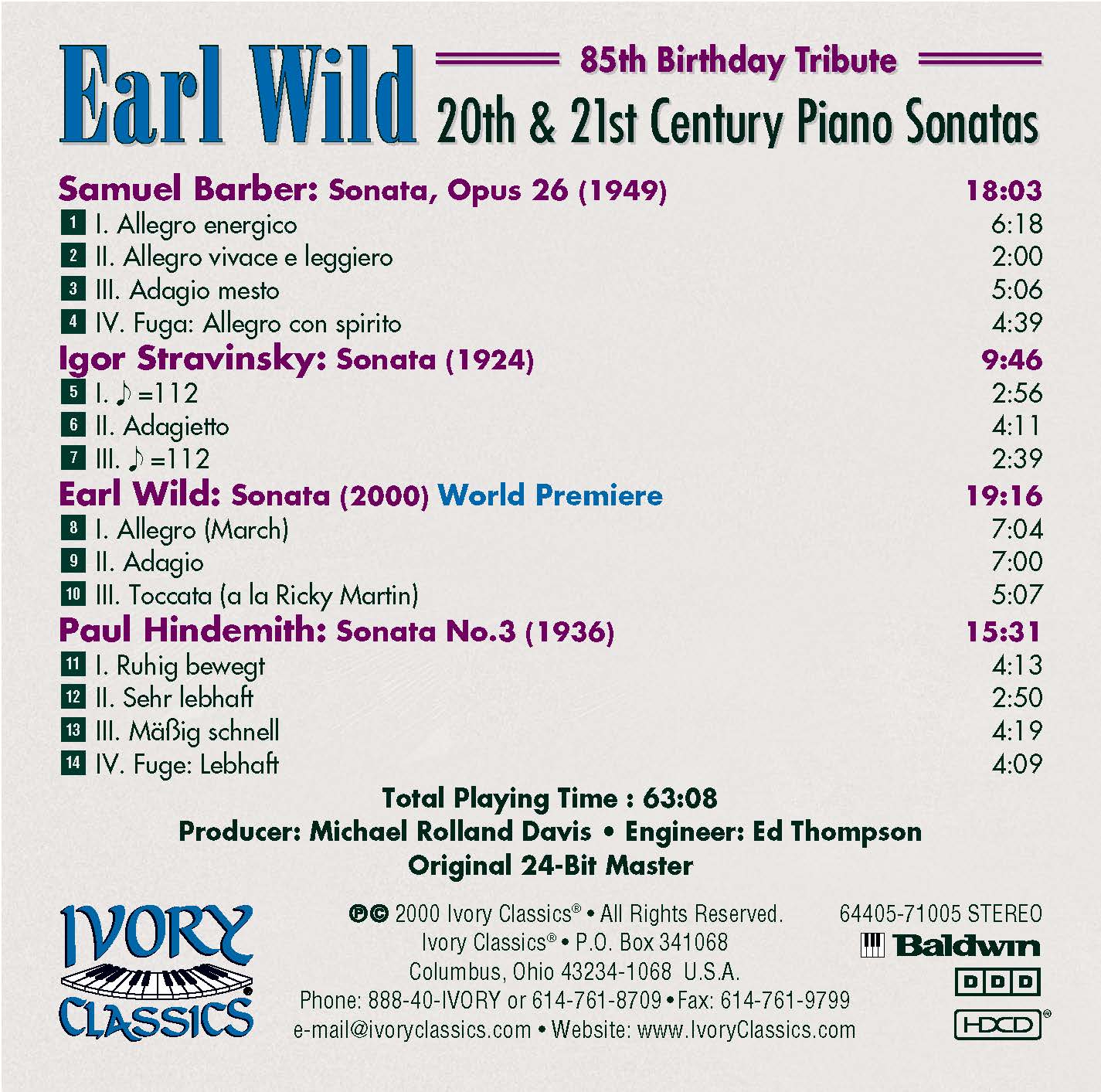Earl Wild's Piano Sonatas of the 20th & 21st Century
Earl Wild's Piano Sonatas of the 20th & 21st Century
Couldn't load pickup availability
Earl Wild's Piano Sonatas of the 20th & 21st Century CD provides a collection of his most renowned performance recordings, ideal for classical music aficionados. The recordings feature clear audio quality and are compiled from his definitive versions to ensure the selection of the highest-quality performances.
Ivory Classics CD-71005
Earl Wild: 20th & 21st Century Piano Sonatas
Piano: Earl Wild
Producer: Michael Rolland Davis
Engineer: Ed Thompson
Piano: Baldwin
(DDD)
Recorded at Fernleaf Abbey, Columbus, Ohio, October 1999 and April 2000
Original 24-Bit Master - HDCD Encoded
The score of Earl Wild's Sonata is available here.
Earl Wild, whose legendary career has spanned over 70 years, performs in this brand new recording four 20th and 21st century piano sonatas. Mr. Wild states: "I had a personal friendship with all four composers on this disc, although one of the relationships has been a little more intimate. I have performed the Hindemith and Stravinsky sonatas in public many times since the 1940s. The Barber Sonata however is a first performance for me. I have the greatest admiration for this wonderful work. My own Sonata was completed in April of this year. A stylistically eclectic work, it incorporates Civil War tunes, echoes of popular music of the 1920s and, in the finale (entitled "Toccata a la Ricky Martin"), there is a distinctive Latin American flavor!
Disc.Reviews
I originally purchased this album, along with several others, to hear various interpretations of the Barber Piano Sonata, which I was working on at the time. (I am a classical pianist by trade) It was immediately apparent that this is one of the best recordings of the Barber available. Mr. Wild's interpretation brings a freshness and naturalness to this work, and with it, a considerable amount of bravura. The performances of the Hindemith and the Stravinsky are no less satisfying. Audiophiles will also appreciate this album's realistic sound. But to my surprise, the most significant aspect of this album is in the recording of Mr. Wild's own Sonata.
If one believes as I, that great art is multifaceted, then this work succeeds on many fronts. First, it draws on several sources that are truly American, utilizing Blues, Jazz, Stomp, Folk, Latin, and even Pop idioms. Second, it weaves these ideas into a taught fabric of a Classical Sonata form, but with a unique twist. Third, the work's harmony is lush and exotic, often calling on extended harmony, chromaticism, and octatonicism in a fashion not unlike other (successful) compositions of the last 100 years. Finally, the piece is a joy to play, being quite idiomatic to the instrument.
In the search for the first piano Sonata to enter the mainstream piano repertoire since Ginastera's first Sonata of the 1950's, Wild's Sonata is a promising candidate indeed
Amazon.com, Nov. 2003
Surprisingly, the Barber Sonata represents a first performance for Wild, although one would hardly guess from the hallmark assurance of the playing. Earl Wild's coolness is wholly apt in the neo-Classical irony of Stravinsky's 1924 Sonata and for the elusive language of the third of Hindemith's 1936 sonatas. The second movement is suitably exuberant. Likewise, the grandiose quasi-Regerian mock-heroics of the concluding double fugue strike just the right balance between bombast and self-deprecating wit. A similarly deliberate and wholly typical lack of pretension and self-conscious intellectuality pervades Wild's own Sonata, in which his affinity with popular 'Americana' is evident, whether in the first movement's conflation of blues elements with Civil War melodies recollected from his grandmother's singing in his youth, or in the Latin American Toccata (a la Ricky Martin) that brings the work to a suitably brilliant conclusion. Some 85-year-old!
International Record Review, Aug. 2001
This CD is an 85th birthday tribute to Earl Wild, and I'm sure that we'd all like our fingers to be as supple and responsive at that age. There's no lack of energy or control and there is an extensive range of pianistic colour. Wild is at his most effective in the harmonically lusher moments - the slow movement of the Barber, and his own Sonata. There is no denying the poise and elegance that Wild brings to these works. The sound of the piano is extremely good. Four stars for performance and five stars for sound.
BBC Music Magazine, Jan. 2001
To celebrate his 85th birthday, ever-young pianist Earl Wild recorded this monumental CD of craggy 20th-century works. The program contains music that would give artists half his age a fit, yet he sails through it like the consummate artist he still is. His playing is always grand in manner and sure in execution; it is like having an artist with 21-year-old fingers coupled with intellect and the wisdom of the ages. The opening movement of the Barber Sonata, restless and probing, sets the stage. Wild brings to it an urgency that has escaped many artists. The same work's Scherzo flies by in sparkling style, the Adagio is exceptionally lyrical and the difficult Fugue gets served up as a thrilling, satisfying virtuoso finale. Wild captures the neoclassical humor and bustle of the Stravinsky Sonata to perfection and provides crystal clear vision for the polyphonic Hindemith work. The pianist's own composition scores high marks and is worthy of the good company it keeps. The excellent recorded sound for all four pieces is clean and crisp, with tangible presence. This is an important, enjoyable release, and a fitting tribute to one of America's greatest performers. I can't wait to hear what Wild does to celebrate his 86th!
Schwann Inside, Dec. 2000
In the Barber Sonata Earl Wild is far more lyrical and cohesive, and yields nothing in the way of virtuosity to Horowitz. It is much more impressive to hear Wild's dazzling, glistening fingerwork in the feathery Allegro vivace e leggiero than to hear Horowitz pound out the opening Allegro. In the Hindemith, Wild eschews overt brilliance, drawing the listener's attention to the architecture of the music from the inside out. Wild has been playing the core repertoire all his life, and his earlier reputation as a splashy showman was merely a result of bad marketing. Wild's own Sonata, just completed earlier this year, unashamedly reflects all aspects of his career. It captures his view of the world with vigor, beauty, and tremendous skill. I look forward to the 100th birthday recital from this great American treasure.
Fanfare Magazine, Dec. 2000
The 20th-century sonatas are by Barber, Hindemith (the Third Sonata), and Stravinsky; Wild composed the 21st century sonata himself. As you might expect, Wild's 20-minute virtuoso work is skillfully and idiomatically written for the keyboard, and highly entertaining. The first movement is energetic with a bluesy interlude; the second movement refers to the popular music of Wild's youth. The finale, a brilliant Toccata, begins to dance in a Latin rhythm, so Wild presents it as an homage to Ricky Martin, whose ease and charm captivated Wild, who is no slouch at ease and charm himself. Wild's performance of the Wild Sonata is brilliant and of course authoritative; the pianist is no less effective in the other sonatas.
Boston Globe, Sep. 2000
Earl Wild breathes fresh air into the Barber Sonata, taking the opening's Allegro Energico marking a face value. The Scherzo and closing fugue are whimsically projected and dance lightly with Mendelssohnian elan. Wild infuses warmth and witty character into the Stravinsky Sonata's deadpan countenance. An old Wild standby, the Hindemith Third, is buoyant, enlivingly articulated, and cogently phrased. Wild's own three-movement Sonata, completed literally days before the recording sessions, is quite attractive and well-made, highlighted by a sustained, lyrical slow movement and a jubilant finale inspired by Ricky Martin's heartthrob-of-the-moment brand of salsa. I hope the outcome of this work will step up Wild's creative productivity, for he is a real composer. He remains an unreal pianist at 85, whose supple fingerwork can easily be mistaken for a young, hotshot firebrand. In sum, this release is on of the finest recordings in Earl Wild's long, individual career, and cannot be recommended too highly.
Classics Today, Aug. 2000
At the age of 85, Earl Wild still operates like a whirlwind force of nature. Endowed with a seemingly limitless finger technique, he is a pianist from a bygone generation - a consummate musician who composes, arranges, and transcribes. For this recording, he composed a wonderfully eclectic and contemporary piano sonata which he finished only days before entering the recording studio. In an almost preternatural way, Wild tosses off the Barber Sonata (especially the Fugue) as though it were child's play. He is one of the few pianists who, regardless of the piece he's playing, has the privilege of taking technical facility for granted. Even the most difficult passages, his playing never sounds labored. He maintains a warmth and involvement that are sometimes lacking in the playing of other equally technically gifted pianists. It is not surprising, then, that Wild's performances of the engaging yet emotionally restrained sonatas by Stravinsky and Hindemith are both technically brilliant and uncharacteristically personalized.
Muse Inc., Aug. 2000
































